Asus VivoPC X Review: Gorgeous Looks, Limited Performance
The Asus VivoPC X offers solid, VR-ready performance within a stunningly small design, but this PC is held back by its lack of upgradability.
Why you can trust Tom's Guide

As virtual reality gets bigger, PCs that can handle VR are getting smaller. Just look at the Asus VivoPC X, which crams a Core i5 processor and a VR-ready GTX 1060 graphics card into a tiny, attractive box that'll look just as sleek in the office as it would in your entertainment center. There's a lot to like about the VivoPC's stunningly small design, solid overall performance and inviting $799 price tag, though the PC's lack of upgradability could make it a lot less future proof than some of its larger and more powerful competitors.
Design
When I first picked up the Asus VivoPC X, I couldn't believe there were actually components inside of it. Asus' miniature desktop is one of the smallest, lightest PCs I've ever used, measuring in at a petite 10.2 x 11 x 3 inches and weighing just 5 pounds. That makes it smaller than the svelte MSI Trident and just barely bigger than Alienware's tiny Alpha console.

While Asus' Republic of Gamers PCs are loud and aggressive, the VivoPC X is sleek and subdued. Its attractively curvy chassis is accentuated by subtle stripes of red, with some nice-looking ridges on the side panel. The desktop is slim and unobtrusive when standing upright; if you lay it flat, it'll slide right into your entertainment center just as easily as a PS4 or Xbox One would.
Ports and Upgradability
One of my only gripes with the VivoPC X is its lack of front-facing ports. As much as I love how seamless the front of the desktop looks, I'd appreciate a few USB ports for plugging controllers in, especially since this thing seems specifically made for the living room.
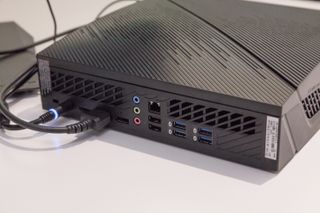
Fortunately, a quick trip to the PC's rear panel gets you access to just about any connection you'll need. There are four USB 3.0 ports, all of which are conveniently labeled with the Oculus logo to let you know where to plug your VR headset in. You've also got two USB 2.0 ports and an Ethernet jack, along with line-in, line-out and microphone jacks. Video-wise, you have access to two HDMI ports and a DisplayPort, giving you plenty of options for connecting to multiple monitors.
The one trade-off of the VivoPC's wonderfully compact design is that there's no real way to upgrade it. Asus tells us that you can technically open up the case with the right know-how, but like the MSI Trident, this little box is meant to stay self-contained. That's fine for now, but could be an issue in a few years when you're trying to run graphically intense games on this thing.
Gaming and VR Performance
With an Nvidia GTX 1060 graphics card tucked into its tiny frame, the VivoPC X offers solid VR-ready gaming performance in a small box.

The PC had no issues with the sleek stealth action of Hitman, running the game's benchmark at a smooth 61 frames per second at 1080p with graphics maxed out. Still, the Asus didn't quite match up to the Trident's 78 fps (Core i7, GTX 1060), nor did it top our 87-fps average.
The VivoPC stumbled a bit in our Rise of the Tomb Raider test (1080p at max settings), churning the game out at a less-than-playable 26.56 fps. That's just below the Trident's 31 fps, and well behind our 60-fps average for gaming PCs. Anecdotally speaking, Rise of the Tomb Raider ran just fine during everyday play, though I had to turn the settings down to medium to get a solid 60 fps or higher.
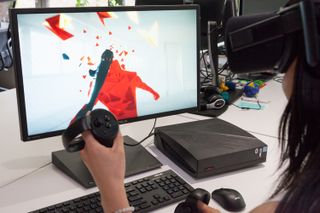
Asus' desktop scored 2,610 on the Fire Strike Ultra test, trailing the Trident by a bit (2,830) and coming up short of our 4,932 category average.
The VivoPC X is largely positioned as a miniature VR machine, and it serves that purpose well. On the SteamVR Performance Test, the desktop scored a 6.7 out of 11, a number that falls well into Valve's VR-ready threshold. The Trident fared a bit better, scoring 7.3, while beefier, GTX 1080-powered machines typically max the test out at 11.
Overall Performance
Packing a 7th-Gen Intel Core i5-7300HQ processor and 8GB of RAM, the VivoPC X is just as reliable for everyday multitasking as it is for VR and gaming. I opened more than a dozen browser tabs, watched five simultaneous Twitch streams, installed the Origin client and ran a full-system scan all at once, and everything still ran smoothly.
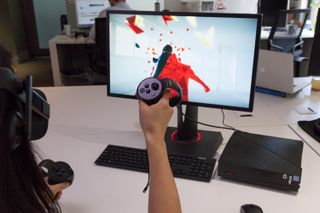
The PC scored 10,501 on the Geekbench 3 performance test, trailing our Core i7-powered versions of the MSI Trident (14,652) and Alienware Alpha (13,762), as well as our 17,507 average.
On our spreadsheet test, the VivoPC matched 20,000 names to addresses in 3 minutes and 49 seconds. That's not quite as quick as the times for the Trident (3:12) or Alpha (3:31), or our 3:18 average, but it's in the same ballpark.

The VivoPC's 1TB SATA hard drive copied about 5GB of files in 3 minutes and 32 seconds, for a sluggish transfer rate of 24 MBps. That's way behind showings by the the 128GB SSD (133.92 MBps) and the Alpha's 1TB hard drive (46.5 MBps), and falls short of our 306.96-MBps average for gaming desktops.
Keyboard and Mouse
The VivoPC X ships with a wireless keyboard and mouse combo; both accessories are pretty no-frills, but they get the job done. I appreciate that Asus opted for wireless peripherals, since the VivoPC is something you'll want to use in your living room.
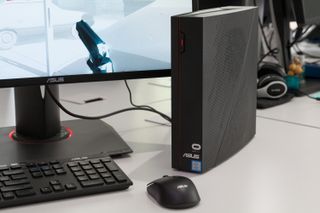
I was able to breeze through the Key Hero typing test at 98 words per minute (which is near my usual speed) at near-perfect accuracy, but the keys felt way too stiff for my liking. The included wireless mouse works just fine (even on a wood desk with no mouse pad), though it's pretty small.
If you plan on using the VivoPC X as your gaming machine, you'll want to spring for a good mechanical keyboard and gaming mouse. But for getting work done or browsing the web, the included peripherals are fine.
Software
The VivoPC X is light on extra software, with just a few handy, gaming-centric audio apps complementing the stock Windows stuff. Sonic Studio is designed for streamers, providing a variety of options for tweaking your microphone output and optimizing your game sound for broadcasting. This app also lets you toggle parameters such as bass and dialogue for whatever you're playing.

Sonic Radar is built to improve the directionality of your game sound. The app lets you adjust the transparency and size of in-game noises on a game-by-game basis, and lets you save profiles for each title. It's a nice bonus feature that could make it easier to hear enemy gunshots from a distance.
Configurations and Value
We reviewed the lone $799 configuration of the VivoPC X, which packs an Intel Core i5-7300HQ processor, 8GB of RAM, a 1TB and 7,200-rpm SATA hard drive, and an Nvidia GTX 1060 GPU. While these specs keep the VivoPC at an attractive price point, they also limit the PC a bit.
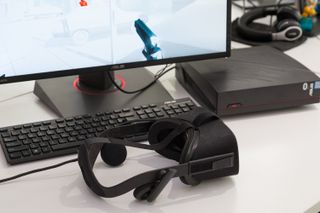
The MSI Trident offers similar specs in its starting, $899 configuration, which makes the VivoPC seem like the better buy. But if you're interested in power, MSI also offers a $1,099 Core i7 version of its compact PC that allows for improved gaming and better overall performance.
Bottom Line
Taken on its own, the VivoPC X is quite the compelling package. It has one of the most attractive compact designs of any PC I've tested, and delivers solid VR-ready power for $799.
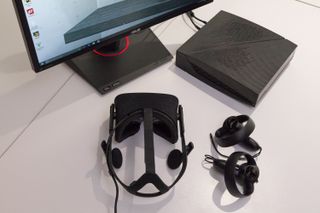
However, if budget isn't a major issue and you need more than base-level gaming and VR performance, you'll want to consider some other options. The MSI Trident ($899 starting) comes in a variety of more powerful configurations, allowing you to enjoy strong Core i7 performance within a similarly sleek design. If you're not strapped for space, the bigger Alienware Aurora starts at $799 with similar specs, but can be easily upgraded with better components over time.
The VivoPC X won't disappoint those looking for a compact, wallet-friendly VR machine, but there are lots of attractive alternatives out there.
Credit: Tom's Guide
Sign up to get the BEST of Tom’s Guide direct to your inbox.
Upgrade your life with a daily dose of the biggest tech news, lifestyle hacks and our curated analysis. Be the first to know about cutting-edge gadgets and the hottest deals.
Mike Andronico is Senior Writer at CNNUnderscored. He was formerly Managing Editor at Tom's Guide, where he wrote extensively on gaming, as well as running the show on the news front. When not at work, you can usually catch him playing Street Fighter, devouring Twitch streams and trying to convince people that Hawkeye is the best Avenger.

